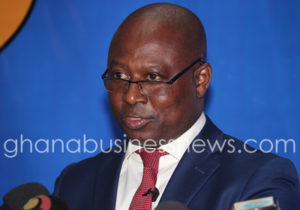Bank of Ghana stays policy rate at 26%, says economy turning the corner

The Bank of Ghana has opted to stay its policy rate at 26 per cent, after its 70th monetary policy meeting, citing easing inflation, stability of the Cedi and a pick-up in economic activity.
“In assessing the current economic conditions, the Committee views the risks to inflation and growth as balanced and therefore decided to maintain the monetary policy rate at 26 per cent,” Dr Abdul-Nashiru Issahaku, Governor of the Bank of Ghana told journalists at his first Monetary Policy Committee (MPC) press conference since becoming governor .
The MPC noted that the increase in headline inflation from 18.5 per cent in February to 19.2 per cent in March was due to delayed effects of the upward adjustment in transport costs, and its subsequent decline to 18.7 per cent in April was consistent with the central bank’s earlier forecast that inflation will peak in the first quarter of 2016 and decline afterwards, barring unanticipated shocks.
The Governor said core inflation (CPI inflation excluding energy and utility prices) also rose in March largely due to higher transport costs, but has returned to a downward path while the latest surveys of the financial sector, businesses and consumers reflect declining trends in inflation expectations.
On growth prospects, Dr Issahaku said economic activity had shown a pick-up and the outlook was positive due to improved energy supply, the Cedi’s stability and the expected increase in oil and gas production.
The Governor said the economy was finally turning the corner, and findings on the growth outlook were positive in surveys by the Bank of Ghana and the Association of Ghana Industries (AGI).
The updated Composite Index of Economic Activity (CIEA) – using indicators such as VAT collection, cement sales and industrial electricity use – showed that economic growth had started to pick-up in the first quarter of 2016, though at a slower pace than the same period a year ago and faced with risks such as tight credit conditions and continued tightness in the fiscal stance, and the global outlook which could moderate the pace of growth.
According to him, the tight policy stance, along with improved inflows, had contributed to the Cedi’s stability – by May 12, 2016, the Cedi had depreciated 0.3 per cent against the US dollar compared with 72 per cent depreciation in the same period of 2015.
“In the near term, the tight policy stance and stability on the foreign exchange market alongside easing inflation expectations, and generally improving fundamentals should provide additional momentum to the disinflation process over the forecast horizon. The MPC therefore views the current monetary policy stance as appropriate since inflation levels remain above the medium term target band of 8±2 per cent”
“In the outlook, the tight policy stance is needed to deepen the gains made on the foreign exchange market and strengthen the disinflation process over the forecast horizon,”
By Emmanuel Odonkor
Copyright © 2016 by Creative Imaginations Publicity
All rights reserved. This news report or any portion thereof may not be reproduced or used in any manner whatsoever without the express written permission of the publisher except for the use of brief quotations in reviews.
